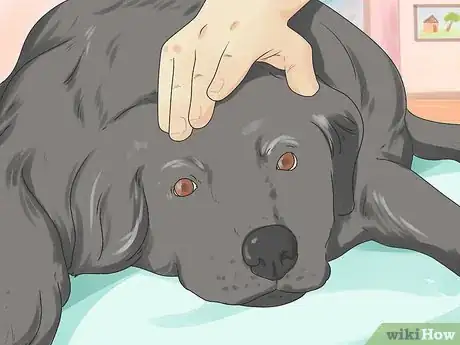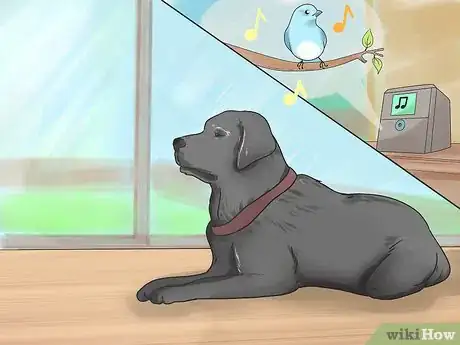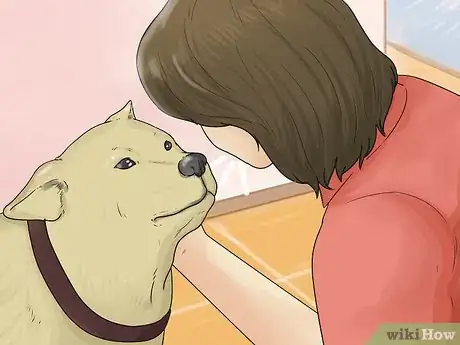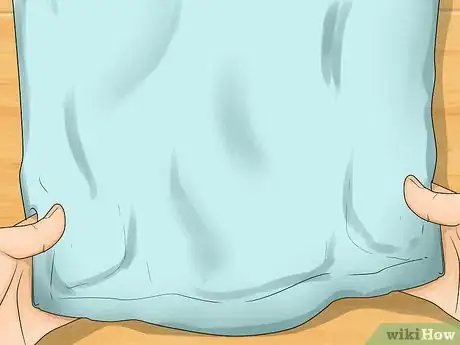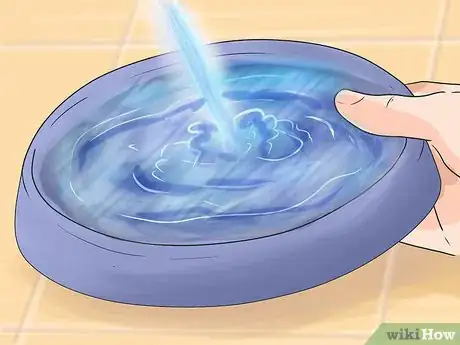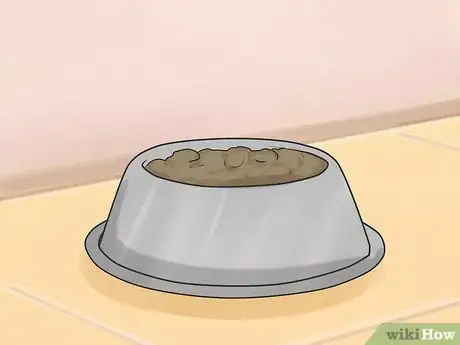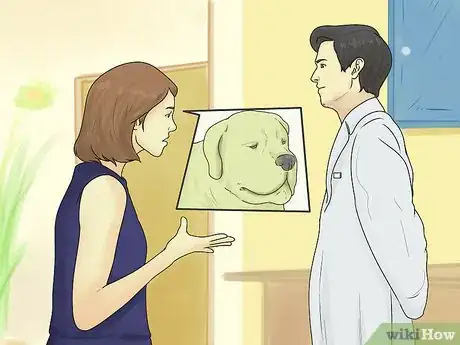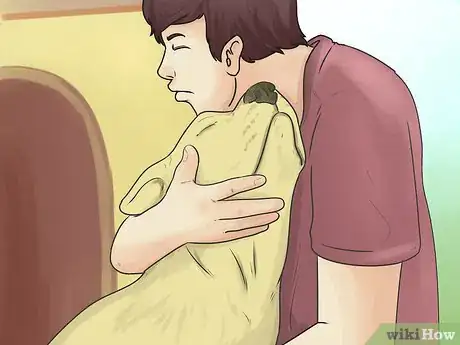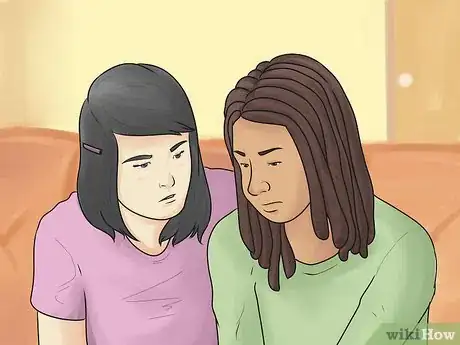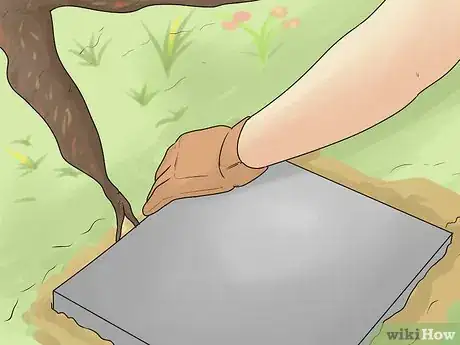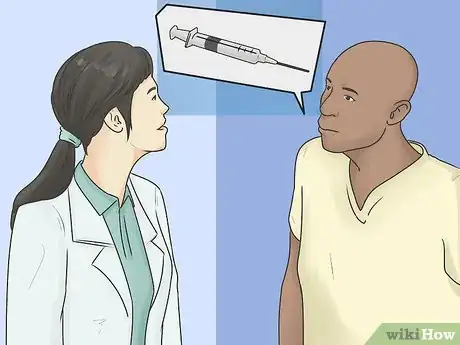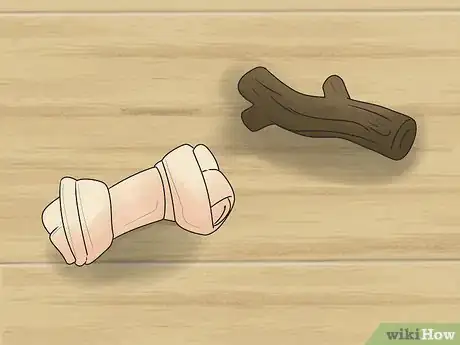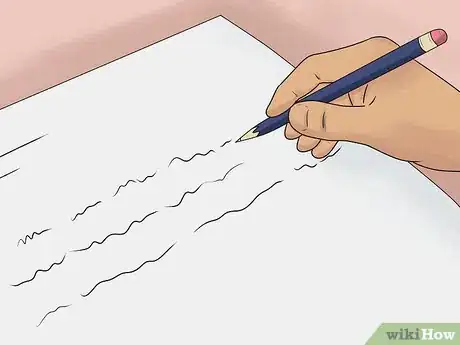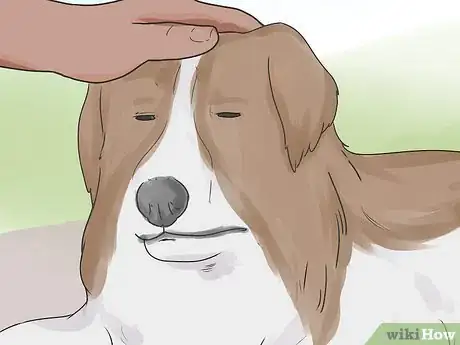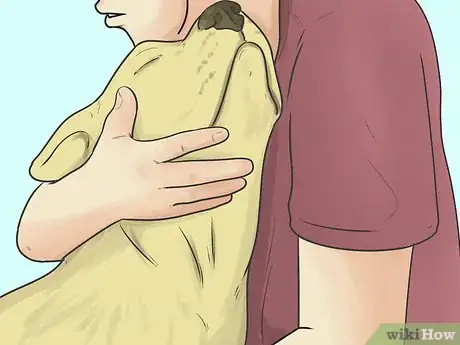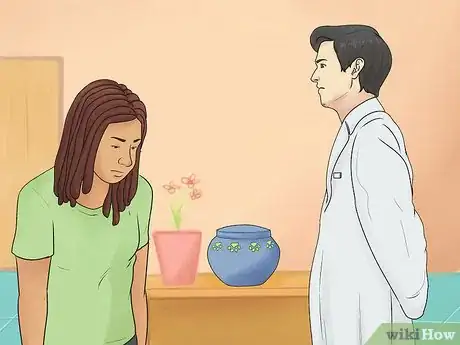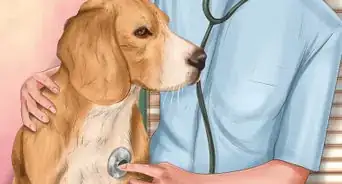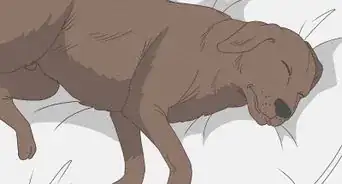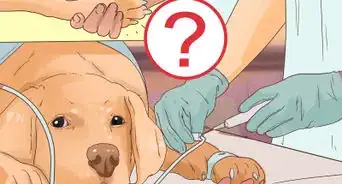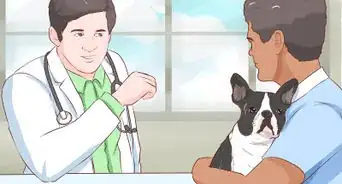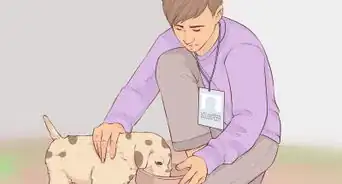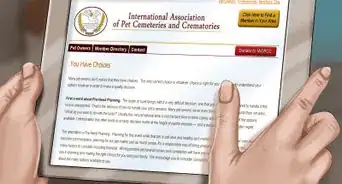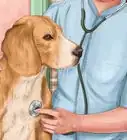This article was co-authored by Pippa Elliott, MRCVS. Dr. Elliott, BVMS, MRCVS is a veterinarian with over 30 years of experience in veterinary surgery and companion animal practice. She graduated from the University of Glasgow in 1987 with a degree in veterinary medicine and surgery. She has worked at the same animal clinic in her hometown for over 20 years.
wikiHow marks an article as reader-approved once it receives enough positive feedback. This article received 14 testimonials and 95% of readers who voted found it helpful, earning it our reader-approved status.
This article has been viewed 369,962 times.
Although it is a natural part of life, it is never easy saying goodbye to your beloved canine companion. During this stage of life, you will want to make your dog as comfortable as possible. The comfort you provide throughout this potentially frightening situation will make the transition easier for your dog and bring you peace of mind as well.
Steps
Comforting Your Dog at Home
-
1Stay patient with your dog. Older dogs commonly begin experiencing joint and muscle problems, and they can become frustrated with their discomfort and impairments. If your dog is grumpy or irritable during the end stages of life, simply do your best to be patient and provide the other comforts you can at home.
-
2Provide a quiet environment. Chaos around the home will only stress both you and your dog as you're trying to spend the final hours of your dog's life together meaningfully and with compassion. Give your dog a quiet environment away from noisy children or other animals in the house.
- Soft, unobtrusive music can also be calming, or you may also use a nature soundtrack with birdsong and the sounds of running water.
Advertisement -
3Speak in comforting tones. Reassure your dog that he's not alone and speak in soft comforting tones. Tell him “good boy” and the other phrases you normally use for positive reinforcement to let him know it's okay. Give him plenty of light pets as well.
- If you want to make sure you're there for the final moments, then you may choose to sleep next to his bed in a sleeping bag for the final nights.
-
4Put down comfortable bedding. If your dog has a favorite dog bed, put it down for him. Otherwise you can put down some other blankets to help him lay down comfortably. Your dog may also have difficulty regulating his body temperature at the end, so keep some blankets handy to put over him in the event that he shows signs of being cold.
- Elderly dogs are also prone to pressure sores, so put down extra cushioning for an older dog.[1]
- On a practical note, he may also have problems with incontinence at the end. Choose a spot you can easily clean and bedding you can wash later. If your dog does have any accidents, then clean them up patiently without scolding him. He can't help it.
- If your dog gets cold, you can also use a heater in the area to make him more comfortable.
-
5Keep fresh water available. Hydration is still important to keeping your dog comfortable even in the final hours. Provide a bowl of water next to the dog bed, so your dog doesn't have to get up to drink. If your is having trouble rising even to drink, then use a clean dropper to help provide water.
-
6Prepare some of his favorite meal. If your dog has always had a favorite thing to eat, then you should make some of it in case he's hungry. However, it is pretty common for dogs to lose their appetite in the end stages of life, so don't force him to eat if he's not hungry.
- Solid food may also upset your dog's stomach at the end as certain systems related to digestion begin shutting down. If your dog still shows a willingness to eat but regular food is upsetting his stomach, then try mixing some baby food with water, or you can also try the Hills A/D diet, which is liquid.
-
7See your veterinarian about pain management. If your dog still has enough time and you're worried about pain in the final stages, then you can consult your vet for pain management options for the final days.[2]
- Signs that your dog might be in pain include excessive panting or gasping for breath or reluctance to move.[3]
-
8Hug your dog one final time. Once your dog passes, give him one final hug and say goodbye. It's a very painful moment, so remember that it's perfectly okay to cry, but also remember the good times you had with your pet and that he passed in a comfortable, loving environment with you doing everything you could.
- Be aware that some dogs seem to "move" or "take a breath" after passing away. As their nervous system shuts down, sometimes muscles in the body or lungs can spasm and look like a sign of life.[4]
- It's also common for dogs to pass with their eyes open.[5] You can close them if you want as you say your final goodbye, or you can pull one of the blankets over his head.
-
9Take care of yourself. Once your pet has passed, know that you did everything you could and worry about taking care of yourself. Seek comfort in other loved ones who understand the loss. You can also light candles or say a small prayer for your pet if it feels right and helps.
- The ASPCA also has a hotline you can call to talk to someone who understands the difficulty of losing a pet. You can reach this hotline at 1-877-GRIEF-10.
-
10Handle your pet's remains. Though it's unpleasant, you do have to do something with your pet's remains once he passes. Many people choose to cremate pets or bury them whether in a pet cemetery or closer to home.[6] Many services are available to help you deal with the remains to make the process easier on you. Look online or ask your vet for services in your area that will help with the option of your choosing.
Comforting Your Dog at the Vet
-
1Consult a professional about euthanasia. The ASPCA has a specific hotline for those dealing with the difficult decision of euthanizing a pet. The line gives you someone to talk to who will understand your grief throughout the process, as well as information about your dog's quality of life at this stage and whether or not euthanasia may be the most humane option.
- You can reach the ASPCA hotline at 1-877-GRIEF-10.
-
2Make the appointment. Though it hurts to do and it always feels too soon, you'll have to make an appointment for the vet to euthanize him when you know your dog is at the end of life. Your vet is likely to suggest this option if your dog's condition has significantly deteriorated and the vet believes the dog is in pain.
-
3Bring some of your dog's favorite items. You'll want to surround your dog with a few of his favorite things at the end. A favorite blanket and a soft toy are very common items that you may choose to bring with to help comfort him as he passes.[7]
- Favorite blankets or a dog bed will also be much more comfortable for your dog than the exam table, especially if he's already in discomfort.
-
4Sign any forms at the vet. When you sign in for the appointment, you'll also have a few forms to fill out, including a consent form signaling that you know what is about to happen. While filling out forms is the last thing you want to focus on, it is a necessary part of the process.
-
5Ask about a sedative beforehand. If your dog is experiencing any pain or discomfort from a medical condition, ask the veterinarian about giving him a sedative. This will make your dog more comfortable, and it will give you the peace of mind later knowing that your dog passed without any pain.[8]
-
6Pet your dog with gentle, loving strokes. Once you've been taken back to the private room and placed your dog down on his blankets with any other items, focus all your energy on spending quality final moments with him. The veterinarian will have to finish setting up the necessary items, so use this time to offer soft praise to your dog. Tell him you love him and pet him in his favorite spots.
-
7Hug your dog. Your vet will ensure you're ready and then begin injecting the solution to euthanize your dog. Many people choose to hug their dog during these moments because the process is fairly quick. Between six and twelve seconds after the solution is delivered, your dog will take a deep breath and then appear to fall into a deep sleep before taking a few more final breaths.[9]
- Some pet owners also prefer not to be in the room for the actual injection and passing.[10] The veterinarian's office is used to people who need to cope and grieve in their own ways. Ultimately decide what is right for you.
-
8Give yourself time. Do not be embarrassed to cry in front of the vet or other employees at the clinic. They all understand what you're going through. After your dog has passed away, your veterinarian will give you the option to spend some additional one-on-one time with your dog. Some owners take this opportunity to say a few last words to their dog while others choose to pass on this option.
-
9Discuss options for the remains. After giving you the time you need, your vet will discuss options concerning what to do with your dog's remains. This may include releasing them to you for burial or cremating them, which the vet can take care of. You can choose cremation either with the intent to take the cremains with you or not.[11]
- In some places, it is against the law for the vet to return your pet's body to you for burial.
Expert Q&A
-
QuestionHow long do dachshunds live?
 Pippa Elliott, MRCVSDr. Elliott, BVMS, MRCVS is a veterinarian with over 30 years of experience in veterinary surgery and companion animal practice. She graduated from the University of Glasgow in 1987 with a degree in veterinary medicine and surgery. She has worked at the same animal clinic in her hometown for over 20 years.
Pippa Elliott, MRCVSDr. Elliott, BVMS, MRCVS is a veterinarian with over 30 years of experience in veterinary surgery and companion animal practice. She graduated from the University of Glasgow in 1987 with a degree in veterinary medicine and surgery. She has worked at the same animal clinic in her hometown for over 20 years.
Veterinarian Dachshunds are a small breed dog, and tend to live longer than larger dogs. The average life expectancy is around 14 - 16 years. Bear in mind that this is just an average; some dogs lead shorter lives, while others live to be older.
Dachshunds are a small breed dog, and tend to live longer than larger dogs. The average life expectancy is around 14 - 16 years. Bear in mind that this is just an average; some dogs lead shorter lives, while others live to be older. -
QuestionWould a dog toilet with a funnel help a dog that is dying and is incontinent?
 Pippa Elliott, MRCVSDr. Elliott, BVMS, MRCVS is a veterinarian with over 30 years of experience in veterinary surgery and companion animal practice. She graduated from the University of Glasgow in 1987 with a degree in veterinary medicine and surgery. She has worked at the same animal clinic in her hometown for over 20 years.
Pippa Elliott, MRCVSDr. Elliott, BVMS, MRCVS is a veterinarian with over 30 years of experience in veterinary surgery and companion animal practice. She graduated from the University of Glasgow in 1987 with a degree in veterinary medicine and surgery. She has worked at the same animal clinic in her hometown for over 20 years.
Veterinarian Anything that will keep the dog from lying in urine and getting urine burn on the skin is a good idea. Other options include puppy pads, which are highly absorbent, or Vetbed. The latter is an artificial sheepskin which wicks moisture away from the dog, and has the advantage that it is very soft, which makes for a comfortable bed.
Anything that will keep the dog from lying in urine and getting urine burn on the skin is a good idea. Other options include puppy pads, which are highly absorbent, or Vetbed. The latter is an artificial sheepskin which wicks moisture away from the dog, and has the advantage that it is very soft, which makes for a comfortable bed. -
QuestionWhy would a dog die suddenly?
 Pippa Elliott, MRCVSDr. Elliott, BVMS, MRCVS is a veterinarian with over 30 years of experience in veterinary surgery and companion animal practice. She graduated from the University of Glasgow in 1987 with a degree in veterinary medicine and surgery. She has worked at the same animal clinic in her hometown for over 20 years.
Pippa Elliott, MRCVSDr. Elliott, BVMS, MRCVS is a veterinarian with over 30 years of experience in veterinary surgery and companion animal practice. She graduated from the University of Glasgow in 1987 with a degree in veterinary medicine and surgery. She has worked at the same animal clinic in her hometown for over 20 years.
Veterinarian There can be any number of reasons, but the most common reasons for sudden death include brain haemorrhage or bloat (Gastric dilatation and volvulus).
There can be any number of reasons, but the most common reasons for sudden death include brain haemorrhage or bloat (Gastric dilatation and volvulus).
References
- ↑ https://www.aspca.org/pet-care/end-life-care-faq#My_Pet_Is_Elderly_Pass_Away
- ↑ https://www.aspca.org/pet-care/end-life-care-faq
- ↑ https://www.aspca.org/pet-care/end-life-care-faq
- ↑ http://www.petplace.com/article/dogs/behavior-training/loss-mourning-a-dog/12-things-you-may-not-know-about-pet-death
- ↑ http://www.petplace.com/article/dogs/behavior-training/loss-mourning-a-dog/12-things-you-may-not-know-about-pet-death
- ↑ http://www.pet-loss.net/funeral.shtml
- ↑ http://www.petmd.com/dog/care/evr_dg_euthanasia_what_to_expect?page=2
- ↑ http://www.petmd.com/dog/care/evr_dg_euthanasia_what_to_expect?page=2
- ↑ http://www.petmd.com/dog/care/evr_dg_euthanasia_what_to_expect?page=2
About This Article
To comfort a dying dog at home, try to put your pet in a quiet room away from noisy children or activity to reduce stress levels. Then, set up a comfortable bed for your dog and make sure it has plenty of fresh water to stay hydrated. In addition, prepare your dog's favorite meal if it still has an appetite. You should also speak to your dog in comforting tones, saying things like "Good boy." Additionally, pet your dog gently so it knows it isn't alone. If you're worried your dog is in pain, see your vet to get pain management advice. For tips on how to deal with your dog's remains and how to comfort a dying dog at the vet, read on!
